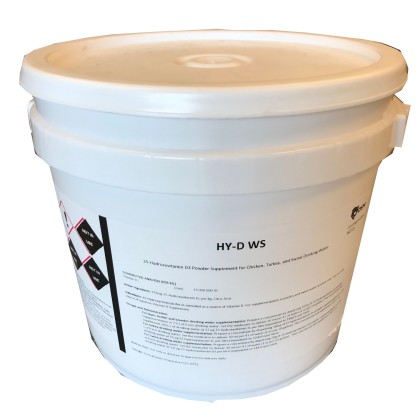-
 Hydrion Ammonia Test Strips provide a simple and economical means of measuring the ammonia concentration in the environment. These test strips are compliant with local animal welfare programs. Simply wet the strip with some water and wave it in the air. After 10-15 seconds compare the colour of the strip against the colour of the chart.
Hydrion Ammonia Test Strips provide a simple and economical means of measuring the ammonia concentration in the environment. These test strips are compliant with local animal welfare programs. Simply wet the strip with some water and wave it in the air. After 10-15 seconds compare the colour of the strip against the colour of the chart. -
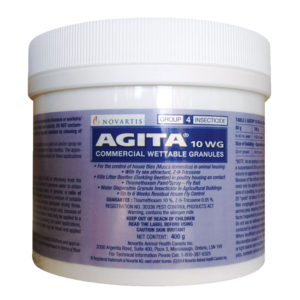 18 or more $44.99 each AGITA 10 WG is a new water dispersible residual insecticidal bait formulation for the control of house flies (Musca domestica) in agricultural buildings (e.g. barns, poultry houses, etc.). The novel combination of a neonicotinoid insecticide with both contact and stomach modes of action, with a house fly sex attractant and a bait, provides an effective fly bait formula which encourages both male and female house flies to remain in treated areas and consume or contact lethal doses of the product. This unique formulation affords the end user up to 6 weeks of residual activity when applied according to label directions. In addition, AGITA 10 WG kills litter beetles (Alphitobius diaperinus) on contact in broiler houses. AGITA 10 WG should be used as part of an integrated pest management program for insects. Directions for Use: General: Use any AGITA 10 WG suspension on the day of mixing, preferably immediately after preparation. Do not treat dirty, highly porous or newly whitewashed walls to prevent loss of long term efficacy. Do not apply on metal and glass surfaces to avoid excessive run-off. Treated surfaces may display a slight, discernible discolouration (white to beige film or powder) when dry, that permits applicators to identify treated surfaces and monitor the rate of bait consumption. Apply ONLY in locations not accessible to children, pets, domestic animals or wildlife, and ONLY on surfaces not routinely contacted by livestock or workers/bystanders. Protect from direct sunlight, water and rainfall. DO NOT contaminate irrigation or drinking water supplies or aquatic habitats by cleaning of equipment or disposal of wastes. AGITA 10 WG is a formulation suitable for application as a paint-on and/or spray-on insecticidal bait for house flies or a contact insecticide for litter beetles. The appropriate recommendations for use rates and individual methods for these applications are as follows: Paint-On for Adult Fly Control: Thoroughly mix the appropriate quantity of AGITA 10 WG to effectively treat the intended surface areas with a corresponding volume of lukewarm water to obtain a suspension with the consistency of a brushable paint. In general, a ratio of 125 grams of AGITA 10 WG per 100 mL of water produces a mixture of suitable consistency that effectively coats surfaces and provides adequate drying times. The freshly prepared suspension should be applied using a brush and, because of the highly attractive nature of the AGITA bait formulation, need only be applied to a small percentage of the available surface area of a building. For paint applications, a daily maximum quantity of 2.0 kg of AGITA 10 WG may be mixed and applied by one person. Because of the effective attractive nature of the AGITA formulation, the suspension need only be applied using a brush to a small percentage of the available surface area of a building. As a general guide, apply the suspension at a rate of approximately 20 “spots” (of about 10 x 30 cm each) per 100 m2 of ground surface, in areas where flies congregate, such as window sills, doors frames, warm wall areas and near animal pens, ensuring that the bait is kept out of reach of animals and away from surfaces frequented by humans and domestic pets. Stir occasionally during application. Do not use on walkways used by animals or on any surfaces that may be routinely contacted by workers or bystanders. Where insufficient surface area is available for painting or where some slight white discoloration caused by the “paint” is unacceptable, paint strips of cardboard, wood or light boards and hang them from the ceiling in locations not accessible to children, pets, domestic animals or wildlife. Spray-On for Adult Fly Control: For applications employing a low-pressure spray applicator, thoroughly mix the Fly Bait with lukewarm water at the ratio of 125 grams of AGITA 10 WG per 1000 mL of water to obtain a mixture of suitable consistency that will effectively coat surfaces while providing adequate drying times. Apply suspension using a standard course spray applicator to appropriate target locations of the wall/ceiling surface area. Again, because the effective attractive nature of the AGITA bait formulation, and unlike “traditional” agricultural fly wall sprays, the suspension need only be applied to a small percentage of the surface area of a building to provide effective fly control. The amount of diluted product required to treat a particular building will vary depending upon the nature of surface to be treated. Apply spray to the point of run-off, while avoiding excessive run-off, to areas where flies congregate, such as window sills/frames, door frames, warm wall areas and near animal pens, ensuring that the bait is kept out of reach of animals and away from surfaces frequented by humans and domestic pets. Stir occasionally during application. Do not use on walkways used by animals or on any surfaces that may be routinely contacted by workers or bystanders. Where insufficient surface area is available for bait application or where some slight discoloration caused by the spray is unacceptable, spray strips of cardboard, wood or light boards and hang them from the ceiling in locations not accessible to children, pets, domestic animals or wildlife. AGITA 10 WG may provide up to six weeks of residual activity, depending upon the size of the resident pest population, re-infestation or re-invasion from neighbouring farms, etc. Estimation of the amount of bait remaining can be determined by observation of the rate at which the slight discolouration of treated surfaces (slight whitish/beige “powder”) disappears. Re-apply the product, as necessary, so as to reduce the possibility of a resident fly population being re-established. The ultimate residual control afforded by AGITA 10 WG will depend upon the size and source of the resident fly population, the re-invasion rates from neighbouring agricultural practices, and the on-farm maintenance, sanitation and hygiene procedures and schedules (e.g. routine removal of fly breeding sites/material, etc.). It is always recommended that AGITA Fly Bait products be used as part of a complete integrated pest management program designed to minimize pest populations and optimize the housing conditions for economic animals. Directions for use against Litter Beetle in Broiler Houses (“Band Spray” Method): AGITA 10 WG kills litter beetles (Alphitobius diaperinus) by direct contact. Using the preparation methods detailed above, AGITA 10 WG should be applied as a suspension in a single 1m wide band at the rate of 4 grams per square metre of surface area (i.e. “band spray method” - ~ 2 to 3 X the house fly control rate). Ensure that the product is mixed with sufficient water to allow a thorough wetting of this 1m wide band on all sides of the broiler house (~1 L per 15 m2). The spray should be applied after cleaning of the facility and the placement of new litter, but just before the house is heated for the arrival of a new batch of chicks. The spray should be applied to the litter beetles’ primary migration routes towards the new litter. The area around any cracks or openings in the ceiling or walls should also be sprayed. The rationale for this program is the fact that the beetles hide in the ceiling or walls between cycles and then crawl out just before the new chicks arrive. At this point, therefore, they will come into contact with the spray band.
18 or more $44.99 each AGITA 10 WG is a new water dispersible residual insecticidal bait formulation for the control of house flies (Musca domestica) in agricultural buildings (e.g. barns, poultry houses, etc.). The novel combination of a neonicotinoid insecticide with both contact and stomach modes of action, with a house fly sex attractant and a bait, provides an effective fly bait formula which encourages both male and female house flies to remain in treated areas and consume or contact lethal doses of the product. This unique formulation affords the end user up to 6 weeks of residual activity when applied according to label directions. In addition, AGITA 10 WG kills litter beetles (Alphitobius diaperinus) on contact in broiler houses. AGITA 10 WG should be used as part of an integrated pest management program for insects. Directions for Use: General: Use any AGITA 10 WG suspension on the day of mixing, preferably immediately after preparation. Do not treat dirty, highly porous or newly whitewashed walls to prevent loss of long term efficacy. Do not apply on metal and glass surfaces to avoid excessive run-off. Treated surfaces may display a slight, discernible discolouration (white to beige film or powder) when dry, that permits applicators to identify treated surfaces and monitor the rate of bait consumption. Apply ONLY in locations not accessible to children, pets, domestic animals or wildlife, and ONLY on surfaces not routinely contacted by livestock or workers/bystanders. Protect from direct sunlight, water and rainfall. DO NOT contaminate irrigation or drinking water supplies or aquatic habitats by cleaning of equipment or disposal of wastes. AGITA 10 WG is a formulation suitable for application as a paint-on and/or spray-on insecticidal bait for house flies or a contact insecticide for litter beetles. The appropriate recommendations for use rates and individual methods for these applications are as follows: Paint-On for Adult Fly Control: Thoroughly mix the appropriate quantity of AGITA 10 WG to effectively treat the intended surface areas with a corresponding volume of lukewarm water to obtain a suspension with the consistency of a brushable paint. In general, a ratio of 125 grams of AGITA 10 WG per 100 mL of water produces a mixture of suitable consistency that effectively coats surfaces and provides adequate drying times. The freshly prepared suspension should be applied using a brush and, because of the highly attractive nature of the AGITA bait formulation, need only be applied to a small percentage of the available surface area of a building. For paint applications, a daily maximum quantity of 2.0 kg of AGITA 10 WG may be mixed and applied by one person. Because of the effective attractive nature of the AGITA formulation, the suspension need only be applied using a brush to a small percentage of the available surface area of a building. As a general guide, apply the suspension at a rate of approximately 20 “spots” (of about 10 x 30 cm each) per 100 m2 of ground surface, in areas where flies congregate, such as window sills, doors frames, warm wall areas and near animal pens, ensuring that the bait is kept out of reach of animals and away from surfaces frequented by humans and domestic pets. Stir occasionally during application. Do not use on walkways used by animals or on any surfaces that may be routinely contacted by workers or bystanders. Where insufficient surface area is available for painting or where some slight white discoloration caused by the “paint” is unacceptable, paint strips of cardboard, wood or light boards and hang them from the ceiling in locations not accessible to children, pets, domestic animals or wildlife. Spray-On for Adult Fly Control: For applications employing a low-pressure spray applicator, thoroughly mix the Fly Bait with lukewarm water at the ratio of 125 grams of AGITA 10 WG per 1000 mL of water to obtain a mixture of suitable consistency that will effectively coat surfaces while providing adequate drying times. Apply suspension using a standard course spray applicator to appropriate target locations of the wall/ceiling surface area. Again, because the effective attractive nature of the AGITA bait formulation, and unlike “traditional” agricultural fly wall sprays, the suspension need only be applied to a small percentage of the surface area of a building to provide effective fly control. The amount of diluted product required to treat a particular building will vary depending upon the nature of surface to be treated. Apply spray to the point of run-off, while avoiding excessive run-off, to areas where flies congregate, such as window sills/frames, door frames, warm wall areas and near animal pens, ensuring that the bait is kept out of reach of animals and away from surfaces frequented by humans and domestic pets. Stir occasionally during application. Do not use on walkways used by animals or on any surfaces that may be routinely contacted by workers or bystanders. Where insufficient surface area is available for bait application or where some slight discoloration caused by the spray is unacceptable, spray strips of cardboard, wood or light boards and hang them from the ceiling in locations not accessible to children, pets, domestic animals or wildlife. AGITA 10 WG may provide up to six weeks of residual activity, depending upon the size of the resident pest population, re-infestation or re-invasion from neighbouring farms, etc. Estimation of the amount of bait remaining can be determined by observation of the rate at which the slight discolouration of treated surfaces (slight whitish/beige “powder”) disappears. Re-apply the product, as necessary, so as to reduce the possibility of a resident fly population being re-established. The ultimate residual control afforded by AGITA 10 WG will depend upon the size and source of the resident fly population, the re-invasion rates from neighbouring agricultural practices, and the on-farm maintenance, sanitation and hygiene procedures and schedules (e.g. routine removal of fly breeding sites/material, etc.). It is always recommended that AGITA Fly Bait products be used as part of a complete integrated pest management program designed to minimize pest populations and optimize the housing conditions for economic animals. Directions for use against Litter Beetle in Broiler Houses (“Band Spray” Method): AGITA 10 WG kills litter beetles (Alphitobius diaperinus) by direct contact. Using the preparation methods detailed above, AGITA 10 WG should be applied as a suspension in a single 1m wide band at the rate of 4 grams per square metre of surface area (i.e. “band spray method” - ~ 2 to 3 X the house fly control rate). Ensure that the product is mixed with sufficient water to allow a thorough wetting of this 1m wide band on all sides of the broiler house (~1 L per 15 m2). The spray should be applied after cleaning of the facility and the placement of new litter, but just before the house is heated for the arrival of a new batch of chicks. The spray should be applied to the litter beetles’ primary migration routes towards the new litter. The area around any cracks or openings in the ceiling or walls should also be sprayed. The rationale for this program is the fact that the beetles hide in the ceiling or walls between cycles and then crawl out just before the new chicks arrive. At this point, therefore, they will come into contact with the spray band.Precautions
KEEP OUT OF REACH OF CHILDREN, PETS, DOMESTIC ANIMALS AND WILDLIFE. Avoid contact with skin, eyes and clothing. Avoid breathing spray mist. Wear coveralls over a long sleeved shirt and long pants, chemical-resistant gloves, shoes and socks when handling the product, clean-up and repair. Wear a NIOSH/MSHA-approved respirator when applying and a NIOSH/MSHA-approved dust-filtering mask during clean-up of the product that is not completely consumed. Wash exposed body parts and change clothing after handling, and before eating, drinking or smoking. Do not contaminate feed, water, food or litter through application or disposal of product. Do not apply bait where animals can lick the product. Prevent accidental transfer of the product, by people or animals, from treated areas to areas used by livestock. FIRST AID: IF SWALLOWED: Call a poison control centre or doctor immediately for treatment advice. Do not induce vomiting unless told to do so by a poison control centre or doctor. Do not give any liquid to the person. Do not give anything by mouth to an unconscious person. IF ON SKIN OR CLOTHING: Take off contaminated clothing. Rinse skin immediately with plenty of water for 15-20 minutes. Call a poison control centre or doctor for treatment advice. IF INHALED: Move person to fresh air. If person is not breathing, call 911 or an ambulance, then give artificial respiration, preferably by mouth-to-mouth, if possible. Call a poison control centre or doctor for further treatment advice. IF IN EYES: Hold eye open and rinse slowly and gently with water for 15-20 minutes. Remove contact lenses, if present, after the first 5 minutes, then continue rinsing eye. Call a poison control centre or doctor for treatment advice. Take container, label or product name and Pest Control Product Registration Number with you when seeking medical attention. TOXICOLOGICAL INFORMATION: There is no specific antidote for this product if ingested. If a large amount has been ingested and emesis is inadequate, lavage stomach. Treat symptomatically. ENVIRONMENTAL HAZARD: Toxic to bees. RESISTANCE MANAGEMENT: For resistance management, thiamethoxam is a Group 4 insecticide. Any house fly population may contain individuals naturally resistant to thiamethoxam and Group 4 insecticides. To delay insecticide resistance, avoid exclusive, repeated use of AGITA Fly Bait or other Group 4 insecticides. Keep accurate records of insecticides used in your operation. Keep the house fly population as low as possible by manure management.Storage
Store product in original, tightly sealed container. Store in a cool, dry place. Do not contaminate water, food or feed by storage or disposal. Do not reuse empty container.Disposal
1. Triple-or-pressure-rinse the empty container. Add the rinsings to the spray mixture in the tank. 2. Follow provincial instruction for any required additional cleaning of the container prior to its disposal. 3. Make the empty container unsuitable for further use. 4. Dispose of the container in accordance with provincial requirements. 5. For information on disposal of unused, unwanted product, contact the manufacturer or the provincial regulatory agency. Contact the manufacturer and the provincial regulatory agency in case of a spill, and for clean-up of spills. MSDS -
 MSDSMultivap Spray Insecticide kills flies before they can breed. Controls house flies, stable flies and gnats.
MSDSMultivap Spray Insecticide kills flies before they can breed. Controls house flies, stable flies and gnats.DIRECTIONS
SPACE SPRAY > Kills flying insects in milking parlors, milkhouses and barns. Direct spray upwards to all parts of the room especially windows and other light sources. Apply at a rate of 1 to 2 seconds per 30 m3. Remove all animals from barn before using as a space spray. For best results, close all doors and windows during treatment. Ventilate treated areas thoroughly for at least 30 minutes before animal re-entry. Spray only when temperature is under 32°C. LIVESTOCK SPRAY > To treat beef and dairy cattle against attack of house flies, stable flies, and gnats. Spray animals once daily with a fine mist. Spray should be enough to wet ends of the hair only; do not wet the hair or skin. Take care not to spray in animal’s eyes. Treat dairy cattle at least 20 minutes before milking. Wash udders before milking. Do not use more often than once a day. PRECAUTIONS > KEEP OUT OF REACH OF CHILDREN > Do not remain in treated areas. Ensure proper ventilation after sealed areas have been treated. Do not spray over milk or milking equipment. Cover milk and milking utensils to prevent contamination from spray and dead insects. Any treated surface that may contact food or feed products should be washed thoroughly with potable water after spraying and before reuse. Do not contaminate food, feed or water troughs. Avoid inhalation of spray. Avoid contact with skin and eyes. Wash exposed skin after using. Product is toxic to fish. Do not contaminate any body of water. CONTENTS UNDER PRESSURE > Do not puncture or incinerate can. Do not store at temperatures above 50°C or in direct sunlight. Do not use in presence of open flame or sparks. FIRST AID > If in eyes > Hold eye open and rinse slowly and gently with water for 15-20 minutes. Remove contact lenses, if present, after the first 5 minutes, then continue rinsing eye. Call a poison control centre or doctor for treatment advice. If on skin or clothing > Take off contaminated clothing. Rinse skin immediately with plenty of water for 15-20 minutes. Call a poison control centre or doctor for treatment advice. If inhaled > Move person to fresh air. If person is not breathing, call 911 or an ambulance, then give artificial respiration, preferably by mouth-to-mouth, if possible. Call a poison control centre or doctor for further treatment advice. If swallowed > Call a poison control centre or doctor immediately for treatment advice. Do not induce vomiting unless told to do so by a poison control centre or doctor. Do not give any liquid to the person. Do not give anything by mouth to an unconscious person. Take container, label or product name and Pest Control Product Registration Number with you when seeking medical attention. TOXICOLOGICAL INFORMATION > Treat symptomatically. This product contains petroleum distillates. Vomiting can cause aspiration pneumonia. NOTICE TO USER > This pest control product is to be used only in accordance with the directions on the label. It is an offence under the Pest Control Products Act to use this product in a way that is inconsistent with the directions on the label. The user assumes the risk to persons or property that arises from any such use of this product. DISPOSAL > When container is empty, press valve to release all remaining pressure. Dispose of empty container in accordance with provincial requirements. For information on the disposal of unused, unwanted product, contact the manufacturer or the provincial regulatory agency. Contact the manufacturer and the provincial regulatory agency in case of a spill, and for clean-up of spills. -
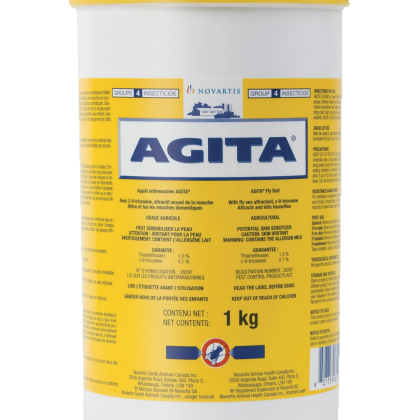 AGITA Fly Bait is a new fly bait formula containing a house fly sex attractant which encourages both male and female house flies to remain in the treated areas, thereby feeding on the bait. Bait should be scattered once per day over fly feeding areas and places where flies are known to congregate to provide initial knockdown and reduction of house fly populations. Scatter AGITA Fly Bait at a rate of 200 g per 100 m2 from a container or other device to avoid handling bait. Bait may also be used in hanging or stationary tamper-resistant bait boxes in locations not accessible to children, pets, domestic animals or wildlife. AGITA Fly Bait should be used as part of an integrated pest management program for house flies. AREAS OF USE: May be used in agricultural buildings (e.g. barns, poultry houses, etc.) in areas where house flies congregate such as windowsills and near animal pens, provided the bait is kept out of reach of animals. Do not use on walkways used by animals.
AGITA Fly Bait is a new fly bait formula containing a house fly sex attractant which encourages both male and female house flies to remain in the treated areas, thereby feeding on the bait. Bait should be scattered once per day over fly feeding areas and places where flies are known to congregate to provide initial knockdown and reduction of house fly populations. Scatter AGITA Fly Bait at a rate of 200 g per 100 m2 from a container or other device to avoid handling bait. Bait may also be used in hanging or stationary tamper-resistant bait boxes in locations not accessible to children, pets, domestic animals or wildlife. AGITA Fly Bait should be used as part of an integrated pest management program for house flies. AREAS OF USE: May be used in agricultural buildings (e.g. barns, poultry houses, etc.) in areas where house flies congregate such as windowsills and near animal pens, provided the bait is kept out of reach of animals. Do not use on walkways used by animals.Precautions
KEEP OUT OF REACH OF CHILDREN, PETS, DOMESTIC ANIMALS AND WILDLIFE. Do not ingest or inhale. Avoid contact with skin, eyes and clothing. Wear coveralls over a long-sleeved shirt and long pants, chemical-resistant gloves, shoes and socks when handling the product.Wear a NIOSH/MSHA-approved dust-filtering mask, long- sleeved shirt, long pants, shoes and socks during the clean up of product which is not completely consumed. Wash exposed body parts and change clothing after handling, and before eating, drinking or smoking. Do not contaminate feed, water, food or litter through application or disposal of product. Do not apply bait where animals can pick it up or lick the product. Prevent accidental transfer of the product, by people or animals, from treated areas to areas used by livestock. Harmful to bees. Do not discharge leftover product into ponds, streams or sewage systems. FIRST AID: If on skin or clothing: Take off contaminated clothing. Rinse skin immediately with plenty of water for 15-20 minutes. Call a poison control centre or doctor for treatment advice. If in eyes: Hold eye open and rinse slowly and gently with water for 15-20 minutes. Remove contact lenses, if present, after the first 5 minutes, then continue rinsing eye. Call a poison control centre or doctor for treatment advice. If swallowed: Call a poison control centre or doctor immediately for treatment advice. Have person sip a glass of water if able to swallow. Do not induce vomiting unless told to do so by a poison control centre or doctor. Do not give anything by mouth to an unconscious person. If inhaled: Move person to fresh air. If person is not breathing, call 911 or an ambulance, then give artificial respiration, preferably by mouth- to-mouth, if possible. Call a poison control centre or doctor for further treatment advice. Take container, label or product name and Pest Control Product Registration Number with you when seeking medical attention. TOXICOLOGICAL INFORMATION: No specific antidote is known. Apply symptomatic therapy. Induce emesis or lavage stomach. STORAGE AND DISPOSAL: Store in original, tightly closed containers. Protect from light and humidity. Do not contaminate water, food or feed by storage or disposal. Do not discharge leftover product into ponds, streams or sewage systems. Do not reuse empty container. Dispose of unused or spoiled bait in accordance with local requirements. Follow provincial instructions for any required cleaning of the container prior to its disposal. Make the empty container unsuitable for further use. Dispose of the container in accordance with provincial requirements. For information on disposal of unused, unwanted product, contact the manufacturer or the provincial regulatory agency. Contact the manufacturer and the provincial regulatory agency in case of a spill, and for the clean-up of spills. MSDS -
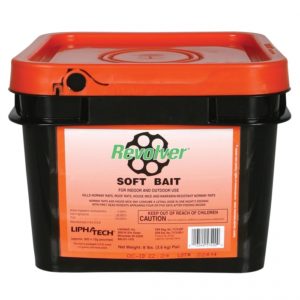 Revolver® soft bait provides a highly palatable formulation of the most widely used active ingredient, Bromadiolone. It is the solution when rotating to a Bromadiolone rodenticide in your biosecurity rodent control program. Revolver contains no wax, increasing palatability and results, in a low-cost per placement 12 gram (0.42 oz.) pouch. Food-grade oils and grains produce an aroma attracting rodents away from competing food sources, providing strong knock-down control of the toughest rodent populations. When compared to competitive green wax-blocks, Revolver no-wax soft bait outperforms and delivers increased palatability, with no bait melt in high temperatures, making it the superior Bromadiolone rodenticide in your bait rotation. No-wax soft bait pouches are easy to use and allow tailored dosing to control heavy rodent infestations or as a low cost per placement monitoring bait, saving producers money and bait waste. Revolver pouches can also be used like a conventional mini-block anchored in a bait station, or end-users can strategically place this unique presentation in tight, hard to reach places where mini-blocks will not fit, targeting where rodents live and reproduce. MSDS
Revolver® soft bait provides a highly palatable formulation of the most widely used active ingredient, Bromadiolone. It is the solution when rotating to a Bromadiolone rodenticide in your biosecurity rodent control program. Revolver contains no wax, increasing palatability and results, in a low-cost per placement 12 gram (0.42 oz.) pouch. Food-grade oils and grains produce an aroma attracting rodents away from competing food sources, providing strong knock-down control of the toughest rodent populations. When compared to competitive green wax-blocks, Revolver no-wax soft bait outperforms and delivers increased palatability, with no bait melt in high temperatures, making it the superior Bromadiolone rodenticide in your bait rotation. No-wax soft bait pouches are easy to use and allow tailored dosing to control heavy rodent infestations or as a low cost per placement monitoring bait, saving producers money and bait waste. Revolver pouches can also be used like a conventional mini-block anchored in a bait station, or end-users can strategically place this unique presentation in tight, hard to reach places where mini-blocks will not fit, targeting where rodents live and reproduce. MSDS -
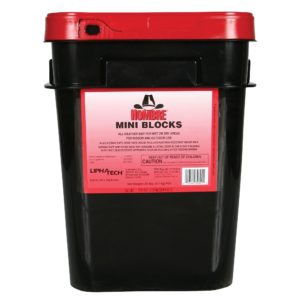 Hombre mini blocks are an ideal choice as the foundation for biosecurity rodent control programs. Formulated with Difethialone, a single feed, second-generation anticoagulant. Mice, roof rats and Norway rats are readily attracted to Hombre mini blocks. Blocks are designed with a center hole for securing to prevent rodents from translocating rodenticide into sensitive areas. MSDS
Hombre mini blocks are an ideal choice as the foundation for biosecurity rodent control programs. Formulated with Difethialone, a single feed, second-generation anticoagulant. Mice, roof rats and Norway rats are readily attracted to Hombre mini blocks. Blocks are designed with a center hole for securing to prevent rodents from translocating rodenticide into sensitive areas. MSDS -
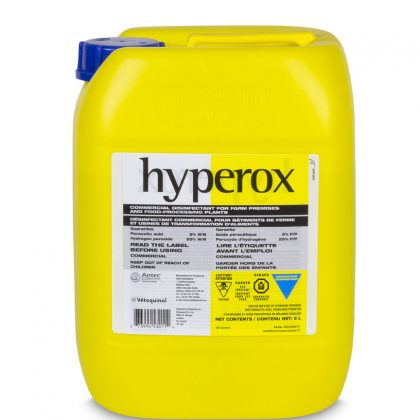 Hyperox consists of a blend of peracetic acid, hydrogen peroxide, acetic acid and surfactant in a long lasting stabilized aqueous solution. Hyperox has a broad spectrum biocidal activity and is non-tainting, does not leave residues after application and degrades to acetic acid, oxygen and water, each of which presents low environmental hazards. DIN 02240361 Active IngredientsPeracetic acid: 5% W/W Hydrogen peroxide: 25% W/W.
Hyperox consists of a blend of peracetic acid, hydrogen peroxide, acetic acid and surfactant in a long lasting stabilized aqueous solution. Hyperox has a broad spectrum biocidal activity and is non-tainting, does not leave residues after application and degrades to acetic acid, oxygen and water, each of which presents low environmental hazards. DIN 02240361 Active IngredientsPeracetic acid: 5% W/W Hydrogen peroxide: 25% W/W.Directions For Use
For best results, pre-clean all surfaces using a detergent before using Hyperox™. For routine disinfection of hard non-porous surfaces like floors, walls, concrete, plastic, stainless steel, glass, enameled surfaces, tile and any other hard non-porous surfaces which are not harmed by water: A 1:256 solution of Hyperox™ (1 part of Hyperox™ in 255 parts of water) is recommended for terminal disinfection. In farm premises: Remove all poultry, livestock and feeds from premises during disinfection. Remove all manure, litter and droppings from floors, walls, and surfaces of facilities occupied or traversed by poultry or livestock. Empty all troughs, racks, and other feeding and watering appliances. Using a pressure washer or mechanical sprayer, saturate surfaces with the solution at a rate of 300 mL per square meter (10 minute minimum contact time) and allow surfaces to dry before restocking. Ventilate building, coops and other closed spaces. All treated feed racks, mangers, troughs, automatic feeders, fountains, and waterers must be thoroughly rinsed with potable water prior to reuse. In food-processing plants: For food contact surfaces, rinse thoroughly with potable water after treatment with Hyperox™. For disinfection of equipment: A 1:128 solution of Hyperox™ (1 part of Hyperox™ in 127 parts of water) is recommended for cleaning and disinfecting equipment (such as buckets and utensils). Remove heavy soil from equipment to be treated. Allow disinfectant solution to remain in contact with the equipment for at least 10 minutes. Any milking equipment or equipment in contact with food where the product has been used should be flushed with potable water prior to reuse. For disinfection of foot and wheel dips: Foot and wheel dips disinfection can be made using a 1:128 solution of Hyperox™ (1 part of Hyperox™ in 127 parts of water). Boots and wheels should be immersed for at least one minute, so as to completely wet surfaces and allowed to air dry. Change foot or wheel dips’ solution when soiled or daily. For disinfection of water systems: A 1:256 solution of Hyperox™ (1 part of Hyperox™ in 255 parts of water) is recommended for water systems disinfection. Drain the system and fill with the solution for a 10 minute contact time. Drain and flush the water lines with potable water after disinfection. For disinfection by fogging: A 1:10 solution of Hyperox™ (1 part of Hyperox™ in 9 parts of water) is recommended for fogging. Use a thermal or mechanical fogging machine and apply at the rate of 17 mL per cubic meter. Leave for 30 minutes and vent for 30 minutes to 1 hour before re-entry.Storage
Store in the original container in a cool, well-ventilated dry room. Keep product away from sources of heat and combustible material. Avoid direct sunlight. Store away from food, feed or other pesticides. Containers must be stored upright only (do not block cap vent).Disposal
Do not reuse container. Follow provincial instructions for any additional cleaning of the container prior to its disposal. Make the empty container unsuitable for further use. Dispose of the container in accordance with provincial requirements. For information on the disposal of unused, unwanted product and the cleanup of spills, contact the provincial regulatory agency or the manufacturer.Precautions
KEEP OUT OF REACH OF CHILDREN: Oxidizing agent, corrosive to the eyes and skin. Do not inhale vapours given off by the product. Harmful or fatal if swallowed. Do not get in eyes, on skin, or on clothing. Wash hands, face and exposed skin before eating, drinking, or smoking, and after leaving the work area. Remove contaminated clothing and wash clothing before reuse. Avoid all contact by mouth, with skin or eyes. Accidental splashes on exposed skin or eyes should be washed off immediately with plenty of water. Wear suitable protective clothing (e.g. aprons, coveralls, complete footwear, etc.), chemical resistant gloves (e.g. nitrile or butyle rubber) and face protection (e.g. face shield, goggles, mask, etc.) when handling the concentrate and during application of product. When applying product by spraying or fogging, wear chemical resistant respirator. Do not remain in treated areas. Ensure proper ventilation after sealed areas have been treated. Do not contaminate food, feed or water troughs. Any treated surface or utensils that may contact food or feed products should be washed thoroughly with potable water after disinfection and before reuse. Do not return unused concentrate to the container in order to avoid possibility of contamination. TOXICOLOGICAL INFORMATION: Hyperox™ is an oxidizing agent and is corrosive and irritant. It can cause severe burns. Treat symptomatically. FIRST AID: Eye contact: If the product or its dilutions are splashed into the eye, rinse immediately with plenty of water or buffered eyewash. Remove any contact lenses. Seek medical advice immediately. Skin contact: Rinse any product off the skin immediately with water. Remove contaminated clothing and wash with water. Seek medical advice immediately. Ingestion: Allow patient to drink water if conscious, but do not induce vomiting. Rinse mouth out with water. Seek medical advice immediately. Inhalation: Remove affected person to fresh air. Keep upper body raised. Keep warm and in a stable position. Seek medical advice immediately. MSDS -
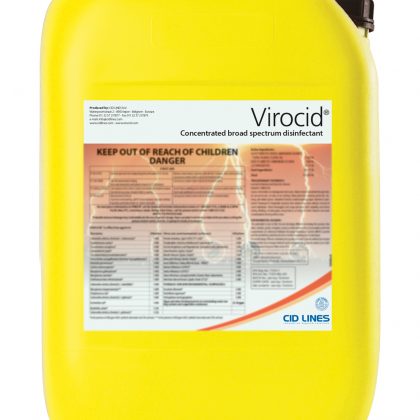 Virocid is a highly concentrated and broad spectrum disinfectant for use in food processing establishments, slaughter houses and livestock industries. Virocid is effective against: viruses, bacteria and fungi. Effective at rates as low as 0.25% (1:400). DIN 02239726 Active Ingredients
Virocid is a highly concentrated and broad spectrum disinfectant for use in food processing establishments, slaughter houses and livestock industries. Virocid is effective against: viruses, bacteria and fungi. Effective at rates as low as 0.25% (1:400). DIN 02239726 Active IngredientsAlkyl (40% C12, 50% C14, 10% C16) dimethyl benzyl ammonium chloride 17.06% Didecyl dimethyl ammonium chloride 7.80% Glutaraldehyde 10.725% Directions For Use
To disinfect hard non-porous surfaces (livestock equipment, floors, walls, table tops, counter tops), apply a 0.25% (1:400) solution to thoroughly wet surface. Spray the surface and let stand for 10 minutes. Virocid is a concentrate that can be used with a mop and bucket, trigger sprayers, sponge, or by soaking. Heavily soiled surfaces should be precleaned prior to disinfection. All food contact surfaces must be thoroughly rinsed with potable water after disinfection.Storage
Store in original container, in a dry, cool place. Do not store in food processing environments.Disposal
1. Rinse the emptied container thoroughly and add the rinsings to the treatment site. 2. Follow local instructions for any required additional cleaning of the container prior to disposal. 3. Make the empty container unsuitable for further use. 4. Disposal of product and packaging: The product and packaging must be disposed of in accordance with local requirements.Precautions
KEEP OUT OF REACH OF CHILDREN. Danger - Corrosive to eyes. Do not get in eyes, on skin or clothing. Use appropriate clothes, gloves and eye protection. Harmful if swallowed. Avoid contamination of food.First Aid
In case of contact, immediately flush eyes or skin with plenty of water for at least 15 minutes. For eyes, call a physician. Remove and wash contaminated clothing before reuse. If inhaled, breathe fresh air and consult a physician. If swallowed, do NOT induce vomiting. Call a physician or poison control centre immediately. MSDS -
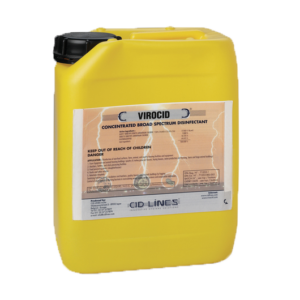 Virocid is a highly concentrated and broad spectrum disinfectant for use in food processing establishments, slaughter houses and livestock industries. Virocid is effective against: viruses, bacteria and fungi. Effective at rates as low as 0.25% (1:400). DIN 02239726 Active Ingredients
Virocid is a highly concentrated and broad spectrum disinfectant for use in food processing establishments, slaughter houses and livestock industries. Virocid is effective against: viruses, bacteria and fungi. Effective at rates as low as 0.25% (1:400). DIN 02239726 Active IngredientsAlkyl (40% C12, 50% C14, 10% C16) dimethyl benzyl ammonium chloride 17.06% Didecyl dimethyl ammonium chloride 7.80% Glutaraldehyde 10.725% Directions For Use
To disinfect hard non-porous surfaces (livestock equipment, floors, walls, table tops, counter tops), apply a 0.25% (1:400) solution to thoroughly wet surface. Spray the surface and let stand for 10 minutes. Virocid is a concentrate that can be used with a mop and bucket, trigger sprayers, sponge, or by soaking. Heavily soiled surfaces should be precleaned prior to disinfection. All food contact surfaces must be thoroughly rinsed with potable water after disinfection.Storage
Store in original container, in a dry, cool place. Do not store in food processing environments.Disposal
1. Rinse the emptied container thoroughly and add the rinsings to the treatment site. 2. Follow local instructions for any required additional cleaning of the container prior to disposal. 3. Make the empty container unsuitable for further use. 4. Disposal of product and packaging: The product and packaging must be disposed of in accordance with local requirements.Precautions
KEEP OUT OF REACH OF CHILDREN. Danger - Corrosive to eyes. Do not get in eyes, on skin or clothing. Use appropriate clothes, gloves and eye protection. Harmful if swallowed. Avoid contamination of food.First Aid
In case of contact, immediately flush eyes or skin with plenty of water for at least 15 minutes. For eyes, call a physician. Remove and wash contaminated clothing before reuse. If inhaled, breathe fresh air and consult a physician. If swallowed, do NOT induce vomiting. Call a physician or poison control centre immediately. MSDS -
 BioSentry 904 Disinfectant is effective in 400 ppm hard water (as CaCO3). Disinfects in 5% organic soil load. Recommended for chicken, turkey, duck, quail, goose, ostrich and other avian hatcheries. Effective in poultry, swine and livestock (including equine) premises. Useful in laboratory animal and animal breeder facilities. BioSentry 904 Disinfectant contains sequestering agents, to prevent the precipitation of minerals and metals from hard water. ● deodorizes by killing most microorganisms that cause offensive odours. ● contains no perfume to mask or hide any odours that might exist. DIN 02319756 Active Ingredients
BioSentry 904 Disinfectant is effective in 400 ppm hard water (as CaCO3). Disinfects in 5% organic soil load. Recommended for chicken, turkey, duck, quail, goose, ostrich and other avian hatcheries. Effective in poultry, swine and livestock (including equine) premises. Useful in laboratory animal and animal breeder facilities. BioSentry 904 Disinfectant contains sequestering agents, to prevent the precipitation of minerals and metals from hard water. ● deodorizes by killing most microorganisms that cause offensive odours. ● contains no perfume to mask or hide any odours that might exist. DIN 02319756 Active IngredientsDidecyl dimethyl ammonium chloride 9.2% Alkyl (C12-67%, C14-25%, C16-7%, C18-1%) dimethyl benzyl ammonium chloride 7.6% Alkyl (C12-40%, C14-50%, C16-10%) dimethyl benzyl ammonium chloride 6.2% Directions For Use
BioSentry 904 Disinfectant is a complete, chemically balanced disinfectant that provides clear use solutions even in cold water. Kills a broad range of gram-negative and gram-positive bacteria, fungi and viruses associated with the avian hatching industry, poultry, swine and livestock (including equine) premises, laboratory animal facilities and kennels. (See antimicrobial efficacy chart on the container label.) DIRECTIONS FOR USE IN FOOD PROCESSING PLANTS: Remove all debris and other deposits from hard, non-porous surfaces to be cleaned or disinfected. Prepare a solution of 4 mL BioSentry 904 Disinfectant per litre of water. Apply liquid with a mop, sponge or cloth, or by spraying, to thoroughly wet surfaces. A minimum contact time of 10 minutes is required for disinfection. For food contact surfaces, scrub and rinse well with potable water before they are reused. DIRECTIONS FOR USE IN AVIAN HATCHERIES: disinfecting precleaned surfaces: Use BioSentry 904 Disinfectant to disinfect precleaned non-porous surfaces including hatchers, setters, trays, racks, egg flats, walls, floors, ceilings and other surfaces in the hatchery environment. It is also excellent for chick boxes, egg cases, vans and trash containers. Preclean the surface to be disinfected with a BioSentry hatchery cleaner. Rinse and if possible let surfaces dry. Then, apply BioSentry 904 Disinfectant at four (4) mL per litre of water (0.40%) by immersion, by flowing solution over treated surfaces, by use of a soft coarse spray, with a clean mop or cloth, or through a foaming apparatus. Thoroughly wet surfaces. Surfaces should remain moist for 10 minutes for complete disinfection. NOTE: Do not spray BioSentry 904 Disinfectant solutions unless workers are protected from breathing the spray mist. SANITIZING HATCHERY ROOMS BY FOG APPLICATION: Close room off so fog is confined to the room to be treated. Mix one (1) part BioSentry 904 Disinfectant to five (5) parts water. Insert the nozzle of the fogger through a suitable opening into the room. With the setting on maximum output, fog for one (1) to three (3) minutes for each 113 cubic meters of space in the room (4000 ft3). Duration of fogging time is dependent on type of fogging equipment used. Refer to fogger instructions. Under no circumstances should a room or building be entered by anyone within 4 hours or until fog has completely settled. NOTE: The fog generated is very irritating to the eyes, skin and mucous membranes. Under no circumstances should a room or building be entered by anyone until the fog has completely settled, normally 1 - 4 hours after the actual fogging. If feeders and waterers were not removed from the premises during treatment, or were not adequately covered to prevent contact with treatment, they should be washed with detergent and water before use for poultry or livestock. SANITIZING INCUBATORS AND HATCHERS BY FOGGING: Prepare a stock solution of 45 mL BioSentry 904 Disinfectant to 1 litre of water. Fog 90 - 240 mL of this into setters and hatchers immediately after transfer. Repeat daily in setters and every 12 hours in hatchers. Discontinue hatcher treatments approximately 24 hours prior to pulling the hatch. Do not allow people to contact or breathe this fog and do not enter machines until the fog has settled (30 - 60 minutes after fogging is completed). To do this, install permanent fogging nozzles in setters and hatchers and use an air compressor to disperse the sanitizing solution as a fog. Contact your BioSentry Technical Representative if you need assistance. It is also satisfactory to fog setters and hatchers with 4 mL of BioSentry 904 Disinfectant per litre of water. If this is done, fog for 30 - 90 seconds once per hour or once every two hours. Contact your BioSentry Technical Representative for assistance. DISINFECTING CHICK VANS, EGG TRUCKS, HATCHERY AND FARM VEHICLES: Clean and rinse vehicles and disinfect with 4 mL BioSentry 904 Disinfectant per litre of water. Rinse after 10 minutes contact. BioSentry 904 Disinfectant should not be mixed with other cleaning or disinfecting compounds or products. DIRECTIONS FOR USE ON POULTRY, SWINE AND LIVESTOCK (INCLUDING EQUINE) FARMS GENERAL FARM DISINFECTANT USES: (4 mL per litre, 1:250) (a) Remove all livestock and feeds from premises, trucks, coops or crates to be treated. (b) Remove all litter, bedding and manure from floors, walls and surfaces of facilities traversed or occupied by animals. (c) Empty all feeding devices and watering appliances. (d) Clean all surfaces with water or water and a compatible detergent. (e) Saturate all surfaces with BioSentry 904 Disinfectant diluted at 4 mL per litre of water using a brush, cloth, mop or mechanical spraying device. Small items (forks, shovels, scrapers) may be immersed. Treated surfaces must remain moist for at least 10 minutes for proper germicidal action. (f) Ventilate buildings, trucks, coops and other closed spaces. Do not house livestock or use equipment until treatment has thoroughly dried. (g) Thoroughly scrub all feeding and watering equipment with detergent and rinse with potable water before reuse. VEAL, CALVING, HOG, CATTLE AND HORSE OPERATIONS: Between depopulations of facilities, cleaning and disinfection of pens, hutches, aisles, ventilation equipment, utensils and other environmental surfaces may be required. Flush soils from these areas and clean and disinfect with 4 mL of BioSentry 904 Disinfectant per litre of water. Take care to avoid disinfectant use solution contact with animals, feed, feed equipment, water or watering devices as indicated above. If spray contacts feeders or waterers, scrub them and rinse well with potable water before they are reused. BOOT BATH: Use 8 mL of BioSentry 904 Disinfectant per litre of water (1:125) in boot baths. Change solution daily and anytime it becomes visibly soiled. Use a nylon bristled brush to clean soils from boots. SANITIZING POULTRY HOUSES AND LIVESTOCK BUILDINGS USING BIOSENTRY 904 DISINFECTANT VIA THERMAL FOGGING: After the building has been depopulated and cleaned as in (a) (b) (c) and (d) under «General Farm Disinfectant Uses», double check to be sure all people, poultry, livestock and pets have vacated the building. Close all windows, doors, louvers, curtains, etc., making the building as closed and tight as possible. Mix one (1) part BioSentry 904 Disinfectant with two (2) parts water in the reservoir of the fogger. With the setting on maximum output, fog the treatment into the room or building to be sanitized. Use a total of one litre of BioSentry 904 Disinfectant for each 186 square meters of floor space. If the area is more than 8 meters high, use two (2) litres per 186 square meters of floor space. In multi-story buildings, the application must be repeated for each floor that is to be sanitized. The fogger itself may be placed just inside the door of the building to be treated, or the nozzle of the fogger may be inserted through a suitable opening in the door or building. The opening should be just large enough to accommodate the nozzle. After fogging, the building should be kept closed for twenty-four hours. After twenty-four hours the fog should have settled and the building can then be opened and aired. The building should be opened for a minimum of twenty-four hours before it is repopulated with poultry or livestock. NOTE: The fog generated is very irritating to the eyes, skin and mucous membranes. Under no circumstances should a room or building be entered by anyone within 4 hours or until the fog has completely settled. If the building or room must be entered before the fog completely settles, then individuals entering the building or room must wear a self-contained respirator approved be NIOSH/MSHA, goggles, long shirt sleeves and pants. If feeders and waterers were not removed from the premises during treatment, or were not adequately covered to prevent contact with treatment, they should be washed with detergent and water before use for poultry and livestock. DIRECTIONS FOR USE IN ANIMAL CARE FACILITIES, ANIMAL RESEARCH CENTERS, ANIMAL BREEDING FACILITIES, KENNELS AND ANIMAL QUARANTINE AREAS: BioSentry 904 Disinfectant is a one-step germicide, fungicide, soapless cleaner and deodorant effective in the presence of organic soil (5% serum). It is non-selective and, when used as directed, will not harm tile, terrazzo, resilient flooring, concrete, painted surfaces, varnished wood, glass or metals. ● To clean and disinfect hard surfaces, use 4 mL of BioSentry 904 Disinfectant per litre of water (1:250). Apply by immersion, flushing solution over treated surfaces or with a mop, sponge, cloth or bowl mop to thoroughly wet surfaces. Prepare fresh solutions daily or when solution becomes visible dirty. ● To clean badly soiled areas, use up to 12 mL per litre of water (1:83). ● To disinfect, allow treated surfaces to stand for at least 10 minutes before wiping or rinsing. ● To control mold and mildew growth on previously cleaned, hard non-porous surfaces, use 4 mL of BioSentry 904 Disinfectant per litre of water. Allow to dry without wiping. Reapply as a new growth appears.Storage And Disposal
(1) Store at room temperature 20C. (2) Store in original container in areas inaccessible to children. (3) Do not store on side. (4) Avoid creasing or impacting of side walls. (5) Do not use or store near heat or open flame.Precautions
KEEP OUT OF REACH OF CHILDREN. DANGER: IRRITANT TO EYES. DO NOT GET IN EYES, ON SKIN OR ON CLOTHING. HARMFUL IF SWALLOWED. AVOID CONTAMINATION OF FOOD. WHEN HANDLING THE CONCENTRATE, OR WHEN THERE IS POTENTIAL FOR EYE CONTACT, WEAR GOGGLES. IF THE BUILDING OR ROOM MUST BE ENTERED, THEN THE INDIVIDUALS ENTERING THE BUILDING OR ROOM MUST WEAR A SELF-CONTAINED RESPIRATOR APPROVED BY NIOSH / MSHA, GOGGLES, LONG SHIRT SLEEVES AND PANTS. FOR GOOD HYGIENE PRACTICES, WEAR CHEMICAL RESISTANT GLOVES WHEN USING THIS PRODUCT. Do not spray or apply this product unless the workers are wearing a face mask with spray mist eliminating cartridges. Do not use BioSentry 904 Disinfectant on feeders or waterers and do not allow contact with food, feed or drinking water. BioSentry 904 Disinfectant should not be mixed with other cleaning or disinfecting compounds. Do not use BioSentry 904 Disinfectant on vaccination needles, equipment or diluent bottles as the residual germicide may render vaccines ineffective. FIRST AID: In case of contact, immediately flush eyes or skin with plenty of water for at least 15 minutes. For contact with eyes, call a physician. Remove and wash contaminated clothing before reuse. If swallowed, promptly drink a large quantity of milk, egg whites, gelatin solution, or if these are not available, drink large quantities of water. Avoid alcohol. Call a physician immediately. Take container, label or product name with you when you seeking medical attention. TOXICOLOGICAL INFORMATION: Probable mucosal damage may contraindicate the use of gastric lavage. Measures against circulatory shock, respiratory depression, and convulsions may be needed. Refer to SDS sheet. MSDS -
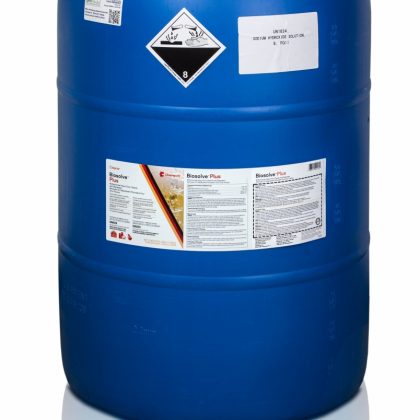 Call for price For the removal of organic soiling especially fats and greases. Biosolve™ Plus is ideal for the removal of fecal matter and soiling on swine, poultry, turkey farms, in the hatchery and animal confinement facilities. Biosolve™ PLUS will remove stubborn fats and grease from all processing equipment such as conveyor belts, separator machines, shackles and cutting blades.
Call for price For the removal of organic soiling especially fats and greases. Biosolve™ Plus is ideal for the removal of fecal matter and soiling on swine, poultry, turkey farms, in the hatchery and animal confinement facilities. Biosolve™ PLUS will remove stubborn fats and grease from all processing equipment such as conveyor belts, separator machines, shackles and cutting blades.Directions For Use
Low or High Pressure Spraying: Prepare a stock solution of Biosolve™ PLUS 2-24 mL/liter (0.25-3.0 ounces per gallon), or calibrate your dosing equipment to achieve this dilution. Spray the solution onto all surfaces at an application rate of 500 mL/m2 (1.6 oz/ft2). Using hot water (60-65°C/140-149°F) will improve the effectiveness of the product, particularly in high grease situations. Allow contact time of 5-10 minutes before thoroughly rinsing all surfaces with clean water at high pressure. Foaming: Prepare a 8-24 mL/liter (1-3 ounces per gallon) stock solution of Biosolve™ PLUS, or calibrate your dosing equipment to achieve this dilution. Apply using a foam lance onto all surfaces at an application rate of 250 mL/m2 (0.8 oz/ft2). Allow a contact time of 5-10 minutes before thoroughly rinsing all surfaces with clean water at high pressure. Food & Egg Processing Equipment, Utensils and Other Food Contact Surfaces: Follow foam cleaning instructions. Thoroughly rinse cleaned surfaces with potable water before they are reused. Where recommended or permitted, apply a sanitizer solution to food contact surfaces before reuse. Recommended Dilution Rates ● Heavy soiling: 16 - 24 mL / L (2.0 - 3.0 ounces per gallon) ● Medium soiling: 8 - 16 mL / L (1.0 - 2.0 ounces per gallon) ● Light soiling: 2.0 - 8.0 mL / L (0.25 - 1.0 ounce per gallon)Storage And Disposal
Store in original container, in areas inaccessible to children. Keep container tightly closed. Do not store on side. Avoid creasing or impacting of side walls. Do not reuse empty container. Discard in trash or recycle. MSDS -
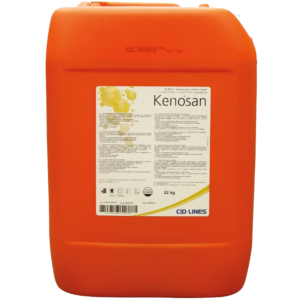 Ultra foaming strong alkaline cleaner. Suitable for agricultural and horticultural use. Strong adhesion power and deep cleaning combine with dissolving power for use in pig, poultry (turkey rearing houses), and dairy houses. This cleaner can also be used for nonporous food contact surfaces in food processing establishments. Apply with normal dosing or Foaming equipment.
Ultra foaming strong alkaline cleaner. Suitable for agricultural and horticultural use. Strong adhesion power and deep cleaning combine with dissolving power for use in pig, poultry (turkey rearing houses), and dairy houses. This cleaner can also be used for nonporous food contact surfaces in food processing establishments. Apply with normal dosing or Foaming equipment.Directions for Use
- Apply at 1oz / gal - 1 1/2 oz / gal with a foam lance and high pressure (min 600 psi)
- Let the product stick for min 20 min and rinse
- Let dry before applying disinfectant
-
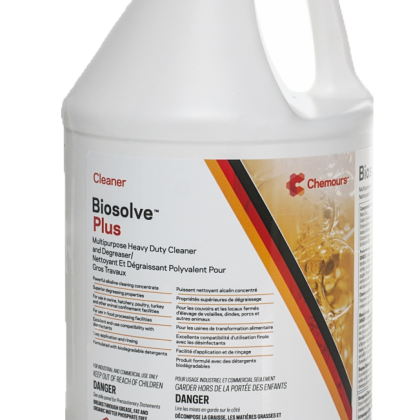 For the removal of organic soiling especially fats and greases. Biosolve™ Plus is ideal for the removal of fecal matter and soiling on swine, poultry, turkey farms, in the hatchery and animal confinement facilities. Biosolve™ PLUS will remove stubborn fats and grease from all processing equipment such as conveyor belts, separator machines, shackles and cutting blades.
For the removal of organic soiling especially fats and greases. Biosolve™ Plus is ideal for the removal of fecal matter and soiling on swine, poultry, turkey farms, in the hatchery and animal confinement facilities. Biosolve™ PLUS will remove stubborn fats and grease from all processing equipment such as conveyor belts, separator machines, shackles and cutting blades.Directions For Use
Low or High Pressure Spraying: Prepare a stock solution of Biosolve™ PLUS 2-24 mL/liter (0.25-3.0 ounces per gallon), or calibrate your dosing equipment to achieve this dilution. Spray the solution onto all surfaces at an application rate of 500 mL/m2 (1.6 oz/ft2). Using hot water (60-65°C/140-149°F) will improve the effectiveness of the product, particularly in high grease situations. Allow contact time of 5-10 minutes before thoroughly rinsing all surfaces with clean water at high pressure. Foaming: Prepare a 8-24 mL/liter (1-3 ounces per gallon) stock solution of Biosolve™ PLUS, or calibrate your dosing equipment to achieve this dilution. Apply using a foam lance onto all surfaces at an application rate of 250 mL/m2 (0.8 oz/ft2). Allow a contact time of 5-10 minutes before thoroughly rinsing all surfaces with clean water at high pressure. Food & Egg Processing Equipment, Utensils and Other Food Contact Surfaces: Follow foam cleaning instructions. Thoroughly rinse cleaned surfaces with potable water before they are reused. Where recommended or permitted, apply a sanitizer solution to food contact surfaces before reuse. Recommended Dilution Rates ● Heavy soiling: 16 - 24 mL / L (2.0 - 3.0 ounces per gallon) ● Medium soiling: 8 - 16 mL / L (1.0 - 2.0 ounces per gallon) ● Light soiling: 2.0 - 8.0 mL / L (0.25 - 1.0 ounce per gallon)Storage And Disposal
Store in original container, in areas inaccessible to children. Keep container tightly closed. Do not store on side. Avoid creasing or impacting of side walls. Do not reuse empty container. Discard in trash or recycle. MSDS -
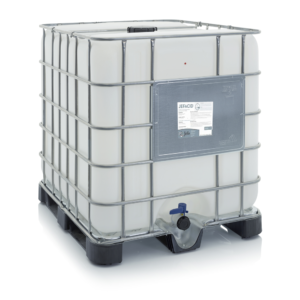 Call for price Jefacid is a liquid acidifier that removes mineral build up and lowers the pH level of the drinking water for livestock. Lowering the pH level also enables a more efficient chlorination process. This will result in good clean economical water which is vital for attaining optimal performance. The product is a blend of phosphoric, citric, lactic and malic acids. MSDS
Call for price Jefacid is a liquid acidifier that removes mineral build up and lowers the pH level of the drinking water for livestock. Lowering the pH level also enables a more efficient chlorination process. This will result in good clean economical water which is vital for attaining optimal performance. The product is a blend of phosphoric, citric, lactic and malic acids. MSDS -
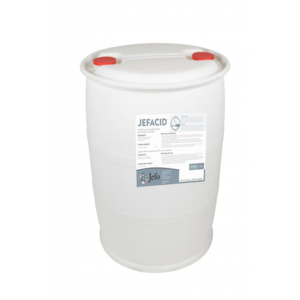 Call for price Jefacid is a liquid acidifier that removes mineral build up and lowers the pH level of the drinking water for livestock. Lowering the pH level also enables a more efficient chlorination process. This will result in good clean economical water which is vital for attaining optimal performance. The product is a blend of phosphoric, citric, lactic and malic acids. MSDS
Call for price Jefacid is a liquid acidifier that removes mineral build up and lowers the pH level of the drinking water for livestock. Lowering the pH level also enables a more efficient chlorination process. This will result in good clean economical water which is vital for attaining optimal performance. The product is a blend of phosphoric, citric, lactic and malic acids. MSDS -
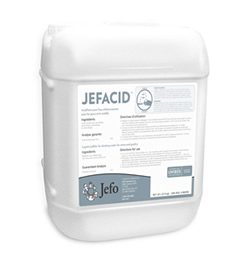 Jefacid is a liquid acidifier that removes mineral build up and lowers the pH level of the drinking water for livestock. Lowering the pH level also enables a more efficient chlorination process. This will result in good clean economical water which is vital for attaining optimal performance. The product is a blend of phosphoric, citric, lactic and malic acids. MSDS
Jefacid is a liquid acidifier that removes mineral build up and lowers the pH level of the drinking water for livestock. Lowering the pH level also enables a more efficient chlorination process. This will result in good clean economical water which is vital for attaining optimal performance. The product is a blend of phosphoric, citric, lactic and malic acids. MSDS -
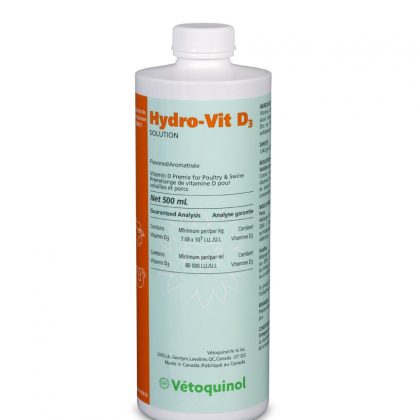 As a supplementary source of Vitamin D for use in drinking water during periods of decreased feed consumption. This treatment applies to the following species: -Chickens, Swine, Turkeys Reg 980677 Guaranteed AnalysisINGREDIENTS: Vitamin D3, BHT, polysorbate 80, benzyl alcohol, sorbitan monostearate. DENSITY: 1.042 g/mL (20°C).
As a supplementary source of Vitamin D for use in drinking water during periods of decreased feed consumption. This treatment applies to the following species: -Chickens, Swine, Turkeys Reg 980677 Guaranteed AnalysisINGREDIENTS: Vitamin D3, BHT, polysorbate 80, benzyl alcohol, sorbitan monostearate. DENSITY: 1.042 g/mL (20°C).Contains Minimum per kg Vitamin D3 7.68 x 107 I.U. Contains Minimum per mL Vitamin D3 80 000 I.U. Directions for Use
Swine: Mix 10 mL of HYDRO-VIT D3 per 2000 L of drinking water, or as directed by nutritionist or veterinarian. Poultry: Mix 20 to 30 mL of HYDRO-VIT D3 per 2000 L of drinking water, or as directed by nutritionist or veterinarian. This product must be agitated while being dispensed or fed.Storage
Protect from heat. The viscosity of this product varies inversely with temperature.Notes
Prepare fresh solutions daily. Net Weight 500mL bottle -
 A water soluble multi-vitamin and electrolyte mixture for chickens, turkeys, swine, cattle, sheep and horses. This treatment applies to the following species: -Beef Cattle, Chickens, Dairy Cattle, Horses, Sheep, Swine, Turkeys DIN 02122022 Active Ingredients (per 400g)
A water soluble multi-vitamin and electrolyte mixture for chickens, turkeys, swine, cattle, sheep and horses. This treatment applies to the following species: -Beef Cattle, Chickens, Dairy Cattle, Horses, Sheep, Swine, Turkeys DIN 02122022 Active Ingredients (per 400g)Vitamin A (Vitamin A acetate) 1 280 000 I.U. Vitamin D3 (Cholecalciferol) 1 000 000 I.U. Vitamin E (Dl-alpha-tocopheryl acetate) 1 500 I.U. Vitamin B12 2560 mcg Folic acid 150 mg Menadione (Menadione sodium bisulfite) 500 mg Calcium-d-pantothenate 3200 mg Niacinamide 6720 mg Riboflavin 1280 mg Choline bitartrate 5760 mg Sodium chloride 277.71 g Sodium acetate 35.71 g Sodium diacetate 7.14 g (Total sodium eq. 120.58 g) Potassium chloride (Potassium eq. 7.48 g) 14.28 g Magnesium chloride (Magnesium eq. 1.82 g) 7.14 g Calcium acetate (Calcium eq. 1.81 g) 7.14 g Directions for Use
Chickens, turkeys, swine, cattle, sheep and horses: - As an aid in stimulating appetite during periods of stress caused by disease, moving, crowding, vaccination, castration or weather. - As an aid in preventing vitamin deficiencies when birds or animals are off normal feed. - As an aid in correcting dehydration and electrolyte imbalance during periods of severe stress, scouring or other enteric diseases that may cause dehydration. - As an aid in recovering from the stress effects of parasites, such as coccidia or intestinal worms. DOSAGE (In drinking water): Chickens, turkeys, swine, cattle, sheep and horses: Dissolve 400 g (1 pouch) of powder in 750 L of drinking water. Treat for 5 days or until feed consumption returns to normal and the effects of dehydration disappear. For automatic proportioner: Set the apparatus to distribute 30 mL per 4 L of water (1 oz./gallon U.S.). Prepare the stock solution by dissolving 400 g (1 pouch) of powder in 5.6 L of water. This will medicate 750 L of drinking water. For continuous low level supplementation of normal diet: Dissolve 400 g (1 pouch) of powder in 2250 L of drinking water. For automatic proportioner: Set the apparatus to distribute 30 mL per 4 L of drinking water (1 oz./gallon U.S.). Prepare the stock solution by dissolving 400 g (1 pouch) of powder in 17 L of water. This will medicate 2250 L of drinking water.Storage
Store between 15°C and 25°C. Protect from moisture. Keep hermetically closed when not used. Keep pail tightly closed when not used.Notes
Prepare fresh solutions daily and mix only the amount that will be consumed in a 24-hour period. Use as the only source of drinking water. 1 teaspoonful equals 5 g. The measuring cup contained herein (10 kg), when filled with a level quantity provides approximately 200 g of product. Net Weight 10kg pail -
 This treatment applies to the following species: -Chickens -Turkeys CFIA Registration No T983937
This treatment applies to the following species: -Chickens -Turkeys CFIA Registration No T983937Guaranteed Analysis:
Copper (min) 12.9 %, Sulfur (min) 6 %, Lead (max) 10.2 mg/kg, Arsenic (max) 4.1 mg/kg, Iron (max) 255 mg/kgList of Ingredients:
Cupric Sulfate (as pentahydrate), USP, 51% w/w, Citric AcidDirections for Use
Dissolve 500 g in 4L of drinking water as a premix (stock) solution. Then give this premix at the rate of 30 mL per 9L of water. Period of use as directed by a veterinarian. Prepare fresh solutions daily.Storage
Keep in a cool dry place. Store below 25 ˚C. Keep from freezing.Caution
Mix thoroughly. Only use according to instructions. Wear protective clothing when handling. Net Weight 10kg pail

